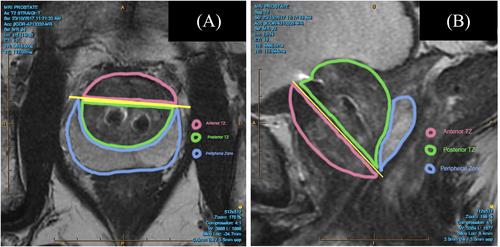Multiparametric-magnetic resonance imaging (mp-MRI) of the prostate and Urolift: Identifying artefact size, location and clinical implications
Abstract
Objectives
We sought to define the degree of artefact caused by prostatic urethral lift (PUL) on multiparametric-magnetic resonance imaging (mp-MRI) to determine the location, size of artefact and if the device could potentially obscure a diagnosis of prostate cancer.
Methods
Ten patients were prospectively enrolled to undergo PUL for treatment of benign prostatic hyperplasia and follow-up imaging. A standard mp-MRI protocol using a 3.0 Tesla scanner was performed prior to and following Urolift insertion. Pre- and post-PUL images were compared to measure maximum artefact diameter around each implant in each MRI parameter. A transverse relaxation time weighted (T2) artefact reduction protocol was also evaluated. The location of each artefact was then compared to a separate database of 225 consecutive patients who underwent magnetic resonance guided prostate biopsies.
Results
Artefact occurred around the stainless steel urethral implant component only. Mean T2 artefact maximum diameter was 7.7 mm (sd = 1.71 mm), with an artefact reduction protocol reducing this to 5.4 mm (sd = 1.43). Mean dynamic-contrast-enhancement artefact was 10 mm (sd = 2.5 mm), and mean diffusion-weighted-imaging artefact was 28.2 mm (sd = 7.8 mm). All artefacts were confined to the posterior transition zone only. In the 225 consecutive patients who had undergone magnetic resonance guided prostate biopsies, there were 55 positive biopsies with prostate cancer, with 13 cases found in the transition zones and no cancer identified solely in the posterior transitional zone.
Conclusions
The stainless steel urethral component of the PUL does cause artefact, which is confined to the posterior transition zone only. PUL artefact occurs in an area of the prostate that has a very low incidence of a single focus of prostate cancer. If there is concern for prostate cancer in the posterior TZ (e.g. if every other area is clear with a high PSA), this area can undergo targeted biopsy.


 求助内容:
求助内容: 应助结果提醒方式:
应助结果提醒方式:


